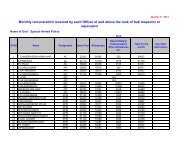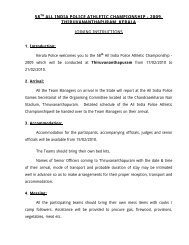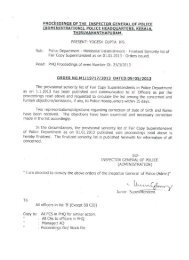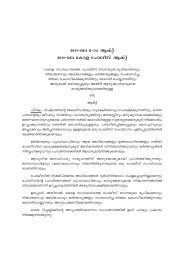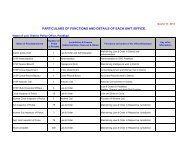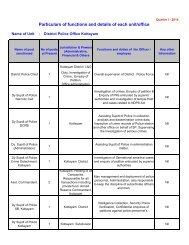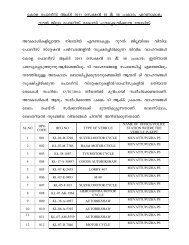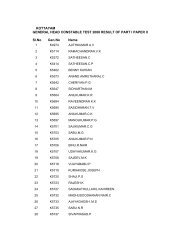Janamaithri Suraksha Project - Kerala Police
Janamaithri Suraksha Project - Kerala Police
Janamaithri Suraksha Project - Kerala Police
You also want an ePaper? Increase the reach of your titles
YUMPU automatically turns print PDFs into web optimized ePapers that Google loves.
g) Publicity and propaganda<br />
Publicity and propaganda are deliberate & guided campaign to induce masses for the<br />
acceptance of and action on given idea. The success attained by CP initiatives today is mainly due<br />
to adequate publicity and due propaganda. The publicity messages were made more potent by<br />
incorporating opposing arguments in a way that tended to discredit them. Such strategy really worked<br />
because the stake holders were given the impression that the ultimate benefit shall go to them and<br />
them only. Care was taken against deliberate lies, double talk, omission of facts, distortion of facts,<br />
exaggeration, prejudiced appeals by certain community men and a section of .unwilling police men/<br />
officers. The police authorities took all the stakeholders on board, held seminars and workshops to<br />
disseminate the concept and allay the disinformation and apprehensions. Publication of success<br />
stories in the media, radio dramas, street plays, website of the state police and many district police<br />
organisations and even of a leading news paper of the state carrying positive aspects of the JSP<br />
helped creating a favourable image in the public. The logo of the JSP gave it an identity of its own.<br />
1.4.2 Implementation Phase<br />
a) Formulation of Standard Operating Procedures<br />
Standard Operating Procedures are the institutionalized implementable set of policy<br />
guidelines published in form of <strong>Police</strong> Orders issued by the DGP of the State or by the Administrative<br />
Department of the Government, e.g., Home Department in this case with its avowed objectives for<br />
uniform application by political executives, bureaucracy and other stakeholders irrespective of the<br />
incumbent in position to implement. In <strong>Kerala</strong> the guidelines for implementation of community<br />
policing scheme, <strong>Janamaithri</strong> <strong>Suraksha</strong> <strong>Project</strong>, were issued and consolidated for over two years,<br />
starting with G.O. No 3161/Home dated 23-11-2007, which briefly spells out the introduction of<br />
Community Policing Scheme in the State and holding of Workshops, Seminars, distribution of<br />
publicity materials and training of police personnel. Subsequently, the Government published<br />
elaborate guidelines, dos & don’ts etc in GO No107/2008/Home dated 21-06-2008. The DGP,<br />
<strong>Kerala</strong> issued Circular No 34/2009 dated 20-08-2009 and 35/2009 dated 21-08-2009, enjoining the<br />
detailed guidelines of the <strong>Janamaithri</strong> <strong>Suraksha</strong> <strong>Project</strong>, role and responsibilities of the Community<br />
<strong>Police</strong> Officers, that of <strong>Janamaithri</strong> <strong>Suraksha</strong> Samithis etc. All these government orders and circulars<br />
helped consolidating the implementation of the scheme.<br />
b) From Pilot <strong>Project</strong> to State-wide Implementation<br />
Pilot implementation is one of the key strategies to evaluate the efficacy of any new project.<br />
Pilot projects makes evaluation and analysis easier and help further developing the concept.<br />
In <strong>Kerala</strong> there are twenty police districts, but the police leadership suggested introducing<br />
<strong>Janamaithri</strong> Surashka <strong>Project</strong>s in fourteen police districts initially, limiting the scheme to twenty<br />
police stations. It was extended to 21 more <strong>Police</strong> Stations in 2009. Subsequently, the scheme<br />
was introduced in 107 police stations of the state, bringing the total number of police stations<br />
covered under <strong>Janamaithri</strong> scheme to 148. Having assessed the popularity and acceptance of the<br />
scheme by the public the <strong>Kerala</strong> government further extended the scheme to 100 more police<br />
stations in 2012. The idea was to market the positive effects of the Scheme among the public and<br />
generate demands from the people of the neighbouring <strong>Police</strong> Stations through their representatives<br />
for introduction of the scheme in their respective police stations. In the process the police leadership<br />
can bargain with the government for more resources for effective implementation of the scheme in<br />
new areas. Here, the praxis correlates to the concept of ‘incrementalism’ (Lindblom, 1959).<br />
c) Hand- holding<br />
Hand holding is an expression meaning providing someone with guidance, assistance,<br />
encouragement or aid and support to lessen anxiety. In the context of implementation of a new,<br />
government sponsored scheme like <strong>Janamaithri</strong> <strong>Suraksha</strong> <strong>Project</strong>, the top police leadership is<br />
expected to constantly guide, aid, support and patronize the scheme at the initial phase of<br />
implementation to overcome the teething problems and make way for wider acceptance by public.<br />
In <strong>Kerala</strong>, the senior police officers passionately played this role till the <strong>Project</strong> received wider<br />
political and public acceptance with scaling up from pilot to state wide implementation. Starting<br />
from selection of the beat police officers, training, monitoring and evaluation the State Level Nodal<br />
Officer played the role of a mentor, constantly guiding and motivating the front line officers in the<br />
department (concepts of Organisational Behaviour theories and Motivational theories).<br />
11



